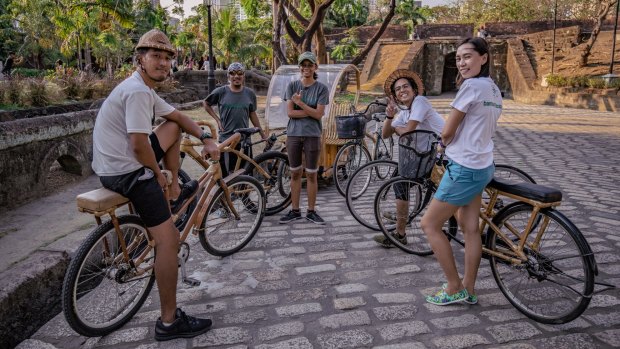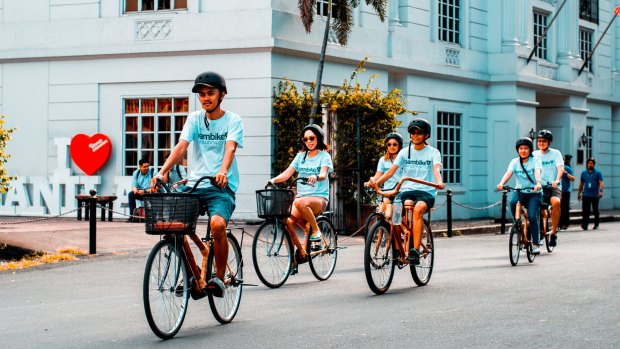This was published 4 years ago
Manila, Philippines: Cycle the city's historic sights on a bamboo bike
By Steve Meacham

Most of your time is spent out of the saddle.
On a Sunday morning in Manila, one of the world's most traffic-choked cities, our guide, Krizyl ("My dad liked inventing names"), leads our party on handmade bamboo bikes through the historic heart of the Filipino capital.
This would be a suicide mission elsewhere in the Manila conurbation that has a population of around 21 million, and an unenvious road mortality rate. But we're cycling through Intramuros – "within the walls" – built by Spanish explorers who declared Manila the capital of their new colony in 1571.
Spread over an archipelago of 7600 islands and 170 languages, the Philippines (named after Phillip II) was the only Spanish colony in south-east Asia. Rich in gold and cinnamon (then a spice worth its weight in gold), the colony was ruled from Intramuros, where 200 Spaniards hid behind 4.5 kilometres of high walls at the point where the Rio de Pasic flows into Manila Bay.

This cycle ride is on exquisitely made bamboo bikes.
The trigger for building Intramuros, Krizyl explains during one of the many stops on our two-hour tour, was the destruction of the first Spanish settlement by Chinese pirates in 1574. But really, Krizyl says, these high walls were a protection against Filipinos like herself. As many canon were aimed inland at local villages as there were out to invaders coming by sea.
Unlike the Portuguese, Dutch or British who also established Asian colonies in the 16th and 17th centuries, the Spanish did not encourage the locals to learn their language for fear of losing their authoritarian grip.
Though this is a cycle ride, on exquisitely made bikes, most of our time is spent out of the saddle. At one stop, we walk to a high point of the wall. Krizyl asks us to look at the massive flag flying over the nearby Rizal monument, named for the martyred independence hero, Jose Rizal. "Look at the colours," she says. "The blue at the top represents peace and justice. The red at the bottom stands for patriotism and valour.
"And in the white triangle, the eight-rayed sun indicates the eight provinces which took part in the 1896 Philippine revolution."
According to history books, Filipinos have only been at war four times and never at their own choosing. Of the invading countries, the first were the Spanish, then the British (briefly, during the Napoleonic Wars), then the Americans (who colonised the country from 1898 to 1946 and which accounts for Filipinos speaking English with an American accent), and finally – and most notoriously – the Japanese in World War II.
"But Filipinos woke up on on Independence Day 2016 (June 12) to discover we were at war again," Krizyl says. "With Facebook!"
In the Philippines if the flag is flown upside down it signals the country is being invaded. To mark Independence Day, Facebook posted an illustration, but the flag was inverted. After much hilarity in Manila, Facebook apologised.
"Why isn't Intramuros World Heritage listed?" I ask Krizyl.
"Because only San Augustin Church [which is listed] survived World War II bombing," she replies. The rest of Intramuros, including those imposing walls, has been rebuilt stone by stone.
During World War II, the Japanese killed 100,000 residents of Manila, and 1.8 million Filipinos in all. "Japan has never apologised," Krizyl says. "But it has donated money towards reconstruction."
Our tour takes us to the Bayleaf Hotel for a glorious rooftop view of Manila and to a museum dedicated to the incomparable polymath Rizal, a poet, novelist, artist and reformist who was executed by firing squad in 1896.
We also stop in at Manila cathedral which was previously destroyed by two fires and four earthquakes. Around 85 million of the country's 105 million population is Catholic making it the third-largest Catholic country in the world after Brazil and Mexico. Two million of the faithful gathered in the small cathedral square when Pope Francis visited in 2015.
The beautiful bamboo bikes we ride are the initiative of Brian McCelland, a Filipino/Scottish/American entrepreneur who in 2010 began a community project manufacturing the bamboo bicycles and thereby increasing the employment options for those in the small town of Victoria, in the province of Tarlac, north of Manila.
Stay behind after the tour with a beer or soft drink to enjoy a video explaining McCelland's philosophy. The whole Bambike adventure is truly inspirational.
TRIP NOTES
Steve Meacham was a guest of Brisbane Airport Corporation, Fairmont Makati, Manila and Philippine Airlines.
MORE
FLY
Philippine Airlines flies to Manila from Brisbane, Sydney and Melbourne. See philippineairlines.com
STAY
Rooms at Fairmont Mataki, Manila start from $A227. See fairmont.com/makati
TOUR
Bambike Ecotours offers various cycling tours in Manila. See bambike.com/ecotours
Sign up for the Traveller Deals newsletter
Get exclusive travel deals delivered straight to your inbox. Sign up now.